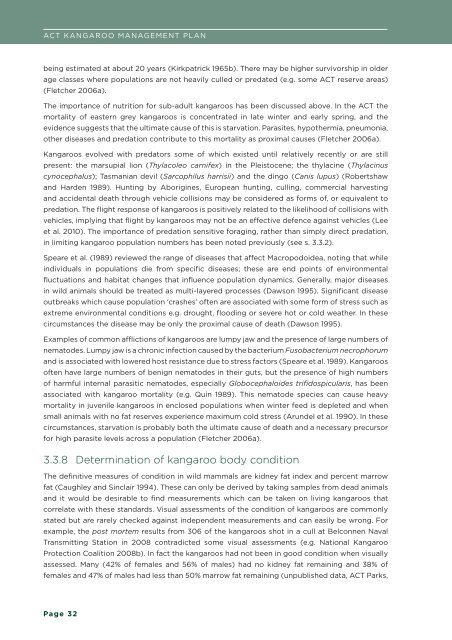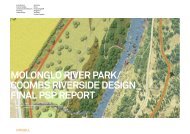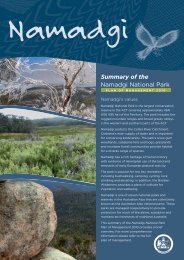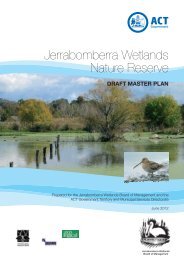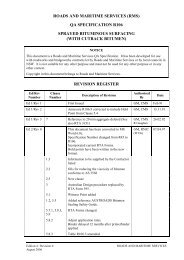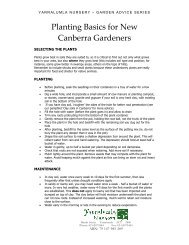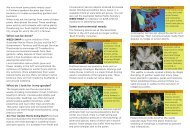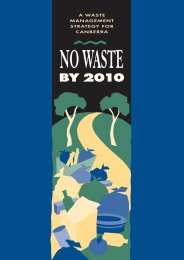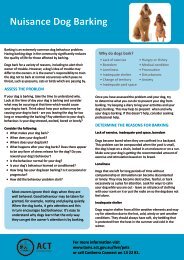Kangaroo Managment Plan - Territory and Municipal Services - ACT ...
Kangaroo Managment Plan - Territory and Municipal Services - ACT ...
Kangaroo Managment Plan - Territory and Municipal Services - ACT ...
You also want an ePaper? Increase the reach of your titles
YUMPU automatically turns print PDFs into web optimized ePapers that Google loves.
<strong>ACT</strong> KANGAROO MANAGEMENT PLAN<br />
being estimated at about 20 years (Kirkpatrick 1965b). There may be higher survivorship in older<br />
age classes where populations are not heavily culled or predated (e.g. some <strong>ACT</strong> reserve areas)<br />
(Fletcher 2006a).<br />
The importance of nutrition for sub-adult kangaroos has been discussed above. In the <strong>ACT</strong> the<br />
mortality of eastern grey kangaroos is concentrated in late winter <strong>and</strong> early spring, <strong>and</strong> the<br />
evidence suggests that the ultimate cause of this is starvation. Parasites, hypothermia, pneumonia,<br />
other diseases <strong>and</strong> predation contribute to this mortality as proximal causes (Fletcher 2006a).<br />
<strong>Kangaroo</strong>s evolved with predators some of which existed until relatively recently or are still<br />
present: the marsupial lion (Thylacoleo carnifex) in the Pleistocene; the thylacine (Thylacinus<br />
cynocephalus); Tasmanian devil (Sarcophilus harrisii) <strong>and</strong> the dingo (Canis lupus) (Robertshaw<br />
<strong>and</strong> Harden 1989). Hunting by Aborigines, European hunting, culling, commercial harvesting<br />
<strong>and</strong> accidental death through vehicle collisions may be considered as forms of, or equivalent to<br />
predation. The flight response of kangaroos is positively related to the likelihood of collisions with<br />
vehicles, implying that flight by kangaroos may not be an effective defence against vehicles (Lee<br />
et al. 2010). The importance of predation sensitive foraging, rather than simply direct predation,<br />
in limiting kangaroo population numbers has been noted previously (see s. 3.3.2).<br />
Speare et al. (1989) reviewed the range of diseases that affect Macropodoidea, noting that while<br />
individuals in populations die from specific diseases; these are end points of environmental<br />
fluctuations <strong>and</strong> habitat changes that influence population dynamics. Generally, major diseases<br />
in wild animals should be treated as multi-layered processes (Dawson 1995). Significant disease<br />
outbreaks which cause population ‘crashes’ often are associated with some form of stress such as<br />
extreme environmental conditions e.g. drought, flooding or severe hot or cold weather. In these<br />
circumstances the disease may be only the proximal cause of death (Dawson 1995).<br />
Examples of common afflictions of kangaroos are lumpy jaw <strong>and</strong> the presence of large numbers of<br />
nematodes. Lumpy jaw is a chronic infection caused by the bacterium Fusobacterium necrophorum<br />
<strong>and</strong> is associated with lowered host resistance due to stress factors (Speare et al. 1989). <strong>Kangaroo</strong>s<br />
often have large numbers of benign nematodes in their guts, but the presence of high numbers<br />
of harmful internal parasitic nematodes, especially Globocephaloides trifidospicularis, has been<br />
associated with kangaroo mortality (e.g. Quin 1989). This nematode species can cause heavy<br />
mortality in juvenile kangaroos in enclosed populations when winter feed is depleted <strong>and</strong> when<br />
small animals with no fat reserves experience maximum cold stress (Arundel et al. 1990). In these<br />
circumstances, starvation is probably both the ultimate cause of death <strong>and</strong> a necessary precursor<br />
for high parasite levels across a population (Fletcher 2006a).<br />
3.3.8 Determination of kangaroo body condition<br />
The definitive measures of condition in wild mammals are kidney fat index <strong>and</strong> percent marrow<br />
fat (Caughley <strong>and</strong> Sinclair 1994). These can only be derived by taking samples from dead animals<br />
<strong>and</strong> it would be desirable to find measurements which can be taken on living kangaroos that<br />
correlate with these st<strong>and</strong>ards. Visual assessments of the condition of kangaroos are commonly<br />
stated but are rarely checked against independent measurements <strong>and</strong> can easily be wrong. For<br />
example, the post mortem results from 306 of the kangaroos shot in a cull at Belconnen Naval<br />
Transmitting Station in 2008 contradicted some visual assessments (e.g. National <strong>Kangaroo</strong><br />
Protection Coalition 2008b). In fact the kangaroos had not been in good condition when visually<br />
assessed. Many (42% of females <strong>and</strong> 56% of males) had no kidney fat remaining <strong>and</strong> 38% of<br />
females <strong>and</strong> 47% of males had less than 50% marrow fat remaining (unpublished data, <strong>ACT</strong> Parks,<br />
Page 32


